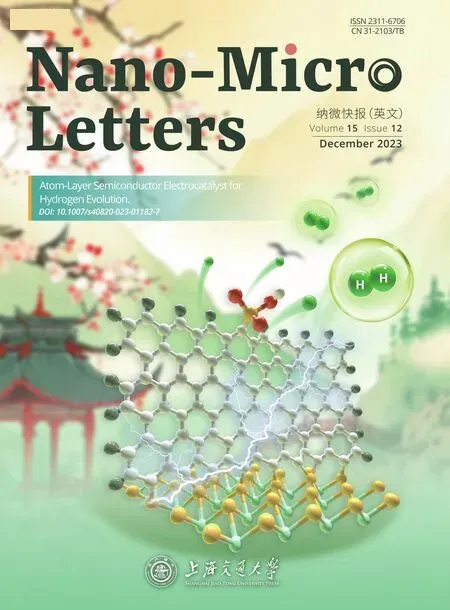Effectively Modulating Oxygen Vacancies in Flower-Like δ-MnO2 Nanostructures for Large Capacity and High-Rate Zinc-Ion Storage
Yiwei Wang, Yuxiao Zhang, Ge Gao, Yawen Fan, Ruoxin Wang, Jie Feng,Lina Yang, Alan Meng, Jian Zhao?, Zhenjiang Li?
ABSTRACT In recent years, manganese-based oxides as an advanced class of cathode materials for zinc-ion batteries (ZIBs) have attracted a great deal of attentions from numerous researchers.However, their slow reaction kinetics, limited active sites and poor electrical conductivity inevitably give rise to the severe performance degradation.To solve these problems, herein, we introduce abundant oxygen vacancies into the flower-like δ-MnO2 nanostructure and effectively modulate the vacancy defects to reach the optimal level (δ-MnO2-x-2.0).The smart design intrinsically tunes the electronic structure, guarantees ion chemisorption-desorption equilibrium and increases the electroactive sites, which not only effectively accelerates charge transfer rate during reaction processes, but also endows more redox reactions, as verified by first-principle calculations.These merits can help the fabricated δ-MnO2-x-2.0 cathode to present a large specific capacity of 551.8 mAh g-1 at 0.5 A g-1, high-rate capability of 262.2 mAh g-1 at 10 A g-1 and an excellent cycle lifespan (83% of capacity retention after 1500 cycles), which is far superior to those of the other metal compound cathodes.In addition,the charge/discharge mechanism of the δ-MnO2-x-2.0 cathode has also been elaborated through ex situ techniques.This work opens up a new pathway for constructing the next-generation high-performance ZIBs cathode materials.
KEYWORDS Znic-ion battery; δ-MnO2 cathode materials; Oxygen vacancy modulation; Large specific capacity; High-rate capability
1 Introduction
Developing low-cost, high-safety and large energy density energy storage devices is extremely necessary for large-scale renewable energy storage system [1-6], of which aqueous zinc-ion batteries (ZIBs) are expected to be the potential devices due to the superior energy densities, suitable redox voltage, affordability and environmental friendliness [7-9].The cathode materials are important components that determine the electrochemical performances of ZIBs [10-14].Among various cathode materials, the transition metal oxides, especially manganese dioxide (MnO2), have become highly competitive candidates because of its high theoretical capacity, multiple crystal structures and wide operating potential [15-17].However, in the previous studies, its actual measured specific capacity was lower than the theoretical value, and the rate capability at the high current density was also poor, which possibly results from the inherent inferior electrical/ionic conductivity and the sluggish reaction kinetics [18-20].Thus, different measures including modulating morphology [21], constructing composites with conductive skeletons [22, 23] and introducing heterogeneous atoms were usually employed [24-26] to break through the bottleneck.Despite the improvement to some extent, these fabricated products still cannot meet the requirements for the high-performance ZIBs cathode materials, which greatly hinders the commercial applications of MnO2in ZIBs field.Therefore, it is urgently needed to exploit a reliable strategy for realizing the target.
Vacancy engineering has become an effective strategy to boost the electrochemical performances of the transition metal oxides (TMOs) [27, 28].It is mainly ascribed to the fact that the oxygen vacancies can act as shallow donors to redistribute the local charge states of the TMOs and significantly modulate the band gap and electron density,thereby fundamentally improving the conductivity [29, 30].Meanwhile, the created vacancy greatly reduces the reaction energy barrier between the electrolyte and the active material, effectively increasing the reaction rate and accelerating the charge transfer [31].Furthermore, the presence of vacancies in the lattice not only decreases the electrostatic repulsion between adjacent layers, greatly accelerating ion migration and reducing the stress induced by ions extraction and insertion [32-34], but also alleviates the spatial potential resistance of ion intercalation and effectively lessens the ions diffusion energy barrier [35, 36].The advantages contribute to drastically promoting their reaction/diffusion kinetics,further elevating the rate capability.On the other hand, the introduction of oxygen vacancies can also generate more electrochemically active sites, increase the surface energy of the system and regulate the geometry of the TMOs, which helps the electrolyte ions to contact with more active materials, further resulting in more redox reactions and essentially increasing the charge storage capacity of the TMOs[37-39].Recently, MnO2with oxygen vacancies has been usually synthesized as the advanced electrode materials for rechargeable sodium-ion batteries and supercapacitors, for example, Chae et al.[40] used a simple solid-state reaction method to synthesize Ca0.07Na0.26MnO2(CNMO) with many vacancy defects as advanced sodium-ion battery cathode materials, which can present high-rate capabilities and superior cycling stability (98.8% capacity retention after the 1000th cycle).Fu et al.[41] designed and constructed MnO2with rich oxygen vacancies via a facile three-step method,which can be acted as cathode materials for supercapacitors.The obtained products can present superior specific capacitance of 452.4 F g-1at 1 A g-1and 316.1 F g-1at 50 A g-1, respectively, which is better than that of the pure MnO2(~ 240 F g-1at 1 A g-1and ~ 180 F g-1at 30 A g-1,respectively).According to the above results, these oxygen vacancies can really enhance charge storage ability of these synthesized MnO2electrode materials.Thus, numerous oxygen vacancies are introduced into the layered MnO2and effectively modulate the vacancy concentration that can possibly present excellent electrochemical performances for ZIBs.To our knowledge, there are few reports in the previous study [42, 43] on the effective regulation of oxygen vacancies in manganese dioxide as a cathode for ZIBs with high specific capacity and rate capability.
In this paper, we used the hydrothermal and reduction treatments to construct typical flower-likeδ-MnO2nanostructures with optimal oxygen vacancies (δ-MnO2-x-2.0),which can be considered as an extraordinary cathode material for ZIBs.The unique cathode materials can hold a high specific capacity, significant rate capability and excellent cycle lifespan since the moderate vacancy level can ensure the ion chemisorption-desorption equilibrium and charge transfer rate during the reaction processes, as well as grant sufficient active sites, which is completely identified by the theoretical calculation.In addition, a co-insertion of H+/Zn2+and phase transition charge storage mechanism inδ-MnO2cathode are illustrated by the ex situ characterization techniques.This work presents a comprehensive understanding for the effect of oxygen vacancy modulation on the electrochemical performances of ZIBs cathode materials, further achieving a valuable design strategy for developing highperformance cathodes for ZIBs, which greatly facilitates the practical application prospects of aqueous ZIBs.
2 Experimental Section
2.1 Materials Preparation
A total of 50 mL of MnSO4solution (0.025 mol L-l) were dissolved in 50 mL of KMnO4solution (0.15 mol L-l) and fully mixed (the molar ratio of MnSO4to KMnO4is 1:1)through magnetic stirring.The mixed solution was magnetically stirred for 1 h and then transferred into a high-pressure reaction autoclave.Then, a piece of graphite substrate with a diameter of 12 mm was also placed in the above autoclave containing a mixed solution.Subsequently, the autoclave was placed into an oven and kept at 160 °C for 12 h.After it was cooled to room temperature, the graphite substrate deposited with some Sepia products are washed three times through deionized water and ethanol to obtainδ-MnO2.Finally, the as-preparedδ-MnO2is treated by reduction treatment in KBH4solution at room temperature, which can introduce rich oxygen vacancies into theδ-MnO2.Through controlling the reduction treatment time, theδ-MnO2with various vacancy concentrations (δ-MnO2-x) can be obtained.Specifically, when the reduction treatment time is determined to be 0.5, 2 and 5 min, the as-prepared samples are named byδ-MnO2-x-0.5,δ-MnO2-x-2.0 andδ-MnO2-x-5.0.The obtained samples can directly act as the working electrodes.
2.2 Materials Characterizations
FESEM (Hitachi, SU8010) and TEM (Hitachi, H-8100)were employed to record the morphology and microstructural information of the prepared samples.XRD (D8 X-ray diffractometer) was used to probe the phase compositions.XPS technique was carried out to further detect the surface composition and valence change on a Thermo ESCALAB 250Xi device with an Al-Kα (hν = 1486.6 eV) excitation source.In order to verify the introduction of the vacancies, electronic paramagnetic resonance (EPR) was conducted using a JES-FA200 EPR spectrometer at X-band(~ 9.4 GHz) with a resolution of 2.44 μT at room temperature.In addition, X-ray absorption fine structure spectroscopy (XAFS) was carried out at the beamline 1W1B of Beijing Synchrotron Radiation Facility.The electron beam energy of the storage ring was 2.5 GeV with ~ 250 mA.
2.3 Electrochemical Characterizations
CR2025-type ZIB cells were constructed using theδ-MnO2as the cathodes, zinc foils (10 μm) as the anodes and glass fiber paper as the separator.The aqueous mixture solution of 2.0 M ZnSO4and 0.1 M MnSO4was used as the electrolyte.Electrochemical workstation was employed to obtain cyclic voltammetry (CV) curves and electrochemical impedance spectrum (EIS).Galvanostatic charge/discharge technique and galvanostatic intermittent titration technique (GITT) were performed on Neware battery testing system to evaluate the specific capacity, rate capability, cycling stability and ion diffusion coefficient.
2.4 Computational Details
The first-principle calculations invoke the Perdew-Burke-Ernzerhof (PBE) formulation of generalized gradient approximation (GGA) [44], and the projected augmented wave (PAW) potentials [45] were carried out via the Cambridge Sequential Total Energy Package(CASTEP) [46].The GGA + U method is used to accurately describe thedelectrons of transition metal Mn, and the Hubbard U parameter was set to be 2.0 eV.The typically exposed MnO2(002) surface was modeled, whereas a vacuum spacing of 15 ? was employed to separate the periodic images.The kinetic energy cutoffwas set as 300 eV, and a Monkhorst-Pack k mesh of 1 × 1 × 1 was adopted to sample the Brillouin zone.All atomic positions were fully relaxed until the forces are below 0.05 eV ?-1,and the electronic energy was considered self-consistent when the energy change was smaller than 1.0 × 10-5eV per atom.
Moreover, ΔE is defined as Eq.(1):
in which Ead/sub, Eadand Esubare the total energies of the optimized adsorbate/substrate system, the adsorbate in the structure and the clean substrate, respectively.
Meanwhile, the free energy (ΔG) of H+and Zn2+on the pristineδ-MnO2andδ-MnO2-xsurface was calculated based on Eq.(2):
where ΔE is the change of total energy from DFT calculations, ZPE and TS stand for the change of zero-point energy and the change of entropic contributions, respectively.
3 Results and Discussion
3.1 Structure, Phase, Valence State and Local Coordination Environment Characterization
A schematic diagram of the synthesis process forδ-MnO2-x-2.0 and the construction of a ZIB device are shown in Scheme 1.The flower-likeδ-MnO2-x-2.0 nanospheres are prepared via a simple hydrothermal method combined with a reduction treatment.First of all, potassium permanganate (KMnO4) and manganese sulfate(MnSO4), respectively, release MnO-4and Mn2+in aqueous solution, then the obtained MnO-4can react with the above Mn2+under high temperature to generate theδ-MnO2.The obtainedδ-MnO2present unique flower-like nanosphere structures assembled by a large number of smooth and interconnected nanosheets.Finally, numerous oxygen vacancies are introduced into the as-preparedδ-MnO2through the reduction treatment in 0.1 M KBH4solution at room temperature for 2 min to achieveδ-MnO2-x-2.0 products.After reduction treatment, the surface of these nanosheets becomes relatively rough and generates many pits at their edges, which can show more active sites to contact the electrolyte ions, thus maximizing the use of the products.Also,the obtained distinct structure effectively promotes charge transfer rate, H+/Zn2+reaction kinetics and ensures the ions chemisorption-desorption equilibrium, which plays a vital role in enhancing their electrochemical performance.Furthermore, a ZIB device is successfully assembled with the fabricatedδ-MnO2-x-2.0 and Zn foil as the cathode and anode, respectively, andδ-MnO2-x-0.5 andδ-MnO2-x-5.0 samples were also prepared by controlling reduction treatment time of 0.5 and 5 min.
From scanning electron microscope (SEM) image ofδ-MnO2(Fig.1a), it exhibits a typical flower-like nanosphere structures consisting of the smooth and intercrossed nanosheets.After introducing the moderate oxygen vacancies into the synthesizedδ-MnO2, the micro-morphology of the obtainedδ-MnO2-x-2.0 is similar to theδ-MnO2;however, the surface of these nanosheets becomes relatively rough because many pits exist on their edges (Fig.1b and c).The distinct architecture can preserve the free open interspaces between the adjacent nanosheets, which can offer various ion transmission channels, effectively quickening the ions migration and guaranteeing the rapid ion diffusion kinetics.Moreover, the structure also enormously alleviates the possible volume change of the active materials induced by the ions intercalation/deintercalation during the charging/discharging process.Besides, the rough surface with numerous pits at their edges can provide adequate active sites for more redox reactions, which is in favor of the sufficient utilization of the active materials.Based on the aforementioned advantages, it can be expected to obtain the high-rate capability and large specific capacity.In addition, the SEM images of the control samples (δ-MnO2-x-0.5 andδ-MnO2-x-5) are depicted in Fig.S1.It can be seen from Fig.S1a,δ-MnO2-x-0.5 shows the well-defined flower-like structures, without any apparent difference in morphology compared with theδ-MnO2-x-2.0 (Fig.1b and c).Nevertheless, the SEM image ofδ-MnO2-x-5.0 shown in Fig.S1b illustrates that the nanosheets are seriously damaged, resulting in the collapse of the flower-like structures due to the excessive reduction treatment.Thus, theδ-MnO2-x-2.0 can be acted as the optimal sample, which will be discussed detailly in the following section.To further confirm the unique structure of theδ-MnO2-x-2.0, transmission electron microscope (TEM) technique is employed as presented in Fig.1d-f.Clearly, the flower-like nanosphere structure ofδ-MnO2-x-2.0 assembled in nanosheets, and the nanosheets are interconnected with each other, generating many free spaces, which is consistent with the SEM observations.The corresponding high-resolution transmission electron microscope (HRTEM) images shown in Fig.1g-i display that the interlayer spacing of 0.24 nm (marked by red and yellow areas) all can assign to the (11-1) crystal plane of MnO2.In addition, elemental mapping of the X-ray energy-dispersive spectrum (EDS mapping) of the representativeδ-MnO2-x-2.0 flower-like nanospheres (Fig.1j-l)shows a uniform distribution of Mn and O across the surface of the products.Therefore, the above SEM and TEM analyses can provide ample evidence for the formation of the unique flower-like micro-structures of theδ-MnO2-x-2.0.
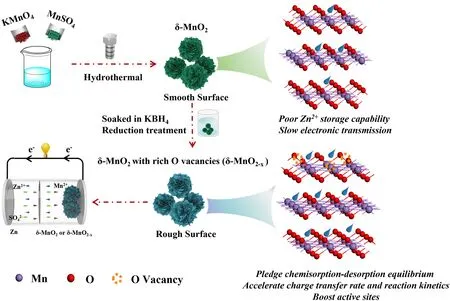
Scheme 1 Schematic diagram of the preparation procedure for δ-MnO2 with rich oxygen vacancies (δ-MnO2-x) and the construction of a ZIB device
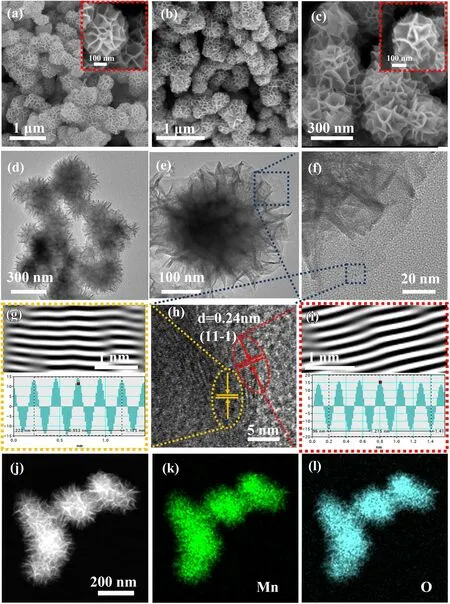
Fig.1 a SEM image of δ-MnO2 with low and high magnification, b low-magnification and c high-magnification SEM images of δ-MnO2-x-2.0, d-f TEM images and g-i HRTEM images of δ-MnO2-x-2.0 and j-l the corresponding EDS mapping of δ-MnO2-x-2.0
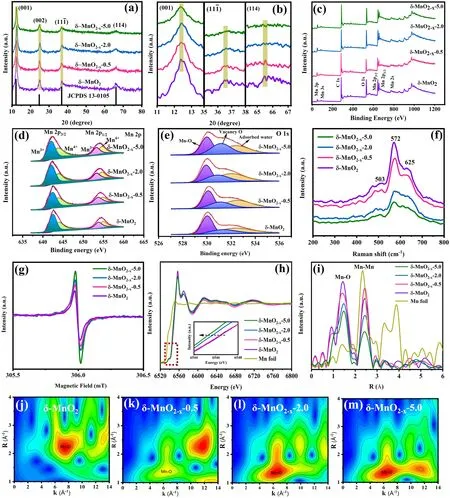
Fig.2 a, b XRD patterns of the δ-MnO2, δ-MnO2-x-0.5, δ-MnO2-x-2.0 and δ-MnO2-x-5.0.c-e XPS plots of δ-MnO2, δ-MnO2-x-0.5,δ-MnO2-x-2.0 and δ-MnO2-x-5.0, a the survey spectra and high-resolution spectra of d Mn 2p and e O 1s.f Raman spectra of the δ-MnO2,δ-MnO2-x-0.5, δ-MnO2-x-2.0 and δ-MnO2-x-5.0.g EPR of the δ-MnO2, δ-MnO2-x-0.5, δ-MnO2-x-2.0 and δ-MnO2-x-5.0.h XANES spectra, i the corresponding FT-EXAFS plots and j-m WT-EXAFS plots at Mn K-edge of δ-MnO2, δ-MnO2-x-0.5, δ-MnO2-x-2.0, δ-MnO2-x-5.0 and Ni foil
In order to examine the phase structure, valence and vacancy defect state of the prepared samples, X-ray diffraction (XRD), X-ray photoelectron spectroscopy (XPS),Raman spectra (Raman), electron paramagnetic resonance(EPR) and X-ray absorption fine structure (XAFS) techniques were employed, and the characterization results are shown in Fig.2.From Fig.2a and b, the main diffraction peaks located at ~ 12.2°, 24.7°, 36.8° and 66.2° correspond to (001), (002), (11-1) and (114) crystal planes,respectively, agreeing well with theδ-MnO2(JCPDS No.13-0105), and no obvious impurities are found.Notably,with the increase in oxygen vacancies, the diffraction peaks intensity of (001), (11-1) and (114) crystal planes of theδ-MnO2-x-0.5,δ-MnO2-x-2.0 andδ-MnO2-x-5.0 gradually become wider and weaker compared with theδ-MnO2, indicating that the created vacancy defects cause a typical disordered structures [47, 48].Furthermore, it can be observed from Fig.2c-e that the chemical composition and valence states of the above products were further investigated by XPS characterization.Figure 2c shows the survey spectra of the four samples, which demonstrates the presence of the Mn and O elements.In the Mn 2pXPS spectrum (Fig.2d), a pair of peaks at 642.5 and 654.8 eV belong to Mn 2p3/2and Mn 2p1/2with a spin energy difference of 12.3 eV, confirming the characteristics of the manganese dioxide phase [49].The four fitted peaks recorded from the Mn 2psuggest that Mn4+and Mn3+coexist inδ-MnO2.Interestingly, the Mn3+/Mn4+integral area proportion gradually enhances from ~ 1.2 (δ-MnO2)to ~ 1.5 (δ-MnO2-x-5.0) because the conversion of Mn4+to Mn3+balances the introduced oxygen vacancies.The O 1sXPS spectra of the samples are depicted in Fig.2e.The peaks located at 530.05, 531.20 and 532.55 eV are attributed to the Mn-O bonds, oxygen vacancy and adsorbed oxygen, respectively [50].Obviously,δ-MnO2-x-5.0 presents larger oxygen vacancy peak intensity than that of other samples, further affirming evidently improved oxygen vacancy concentration after the reduction treatment, well consistent with the previously reported studies [51, 52].Meanwhile, these samples were also investigated by Raman spectra analysis as displayed in Fig.2f.It illustrates that the characteristic peaks at 503, 572 and 625 cm-1are assigned to the stretching mode (Mn-O) of the MnO6octahedron [53].With the gradual reduction or even disappearance of these peaks inδ-MnO2-x-0.5,δ-MnO2-x-2.0 andδ-MnO2-x-5.0, it is strongly related that the effective change to the interlayer covalent interaction of Mn-O occurred after creating various oxygen vacancies [54].Also, EPR measurements were carried out to provide fingerprint evidence for exploring the vacancies in the samples.As shown in Fig.2g, they all possess an electron spin resonance (ESR) signal atg= 2.0 due to the electrons trapped on the vacancies [55].Theδ-MnO2-x-5.0 holds the highest ESR intensity among these samples, suggesting the existence of sufficient oxygen vacancies in the products.In addition, the presence of oxygen vacancies was further substantiated using XAFS spectroscopy.In the K-edge X-ray absorption near-edge structure (XANES) spectra of Mn (Fig.2h),the Mn K-edge binding energy of the obtained samples gradually migrates to a lower direction as the augment of vacancy concentration, which reveals that the structural symmetry inδ-MnO2is partially disturbed, and some Mn4+are reduced to Mn3+after forming oxygen vacancies into the products, which is in accordance with the XPS tests [56].To better understand the coordination environment of the four samples, the Fourier transform extended X-ray absorption fine structure (FT-EXAFS)spectra of the Mn K-edge ofδ-MnO2,δ-MnO2-x-0.5,δ-MnO2-x-2.0 andδ-MnO2-x-5.0 are conducted plotted in Fig.2i.The strong peaks centered at ~ 2.2 and 2.5 ? in the Mn K-edge spectra infer to the Mn-O and Mn-Mn coordination states, respectively [57].Clearly, the peak intensity of Mn-O for theδ-MnO2is relatively higher than those of other samples.When the oxygen vacancies were created into the products, the corresponding peak intensity of Mn-O is gradually decreased ranging fromδ-MnO2-x-0.5 toδ-MnO2-x-5.0, which can be ascribed to the removal of more oxygen sites, greatly increasing the degree of structural distortion [58].As an important complement to FT-EXAFS, the visual wavelet transform(WT) contour maps own power resolution in R-space.As a result, the corresponding coordination path of the prepared samples can be obviously seen from the magnified WT images (Fig.2j-m).All the above analyze results demonstrate that the controlled oxygen vacancies can be successfully introduced into the obtained samples by modulating reduction treatment time.
3.2 Electrochemical Performances and Kinetics Analysis
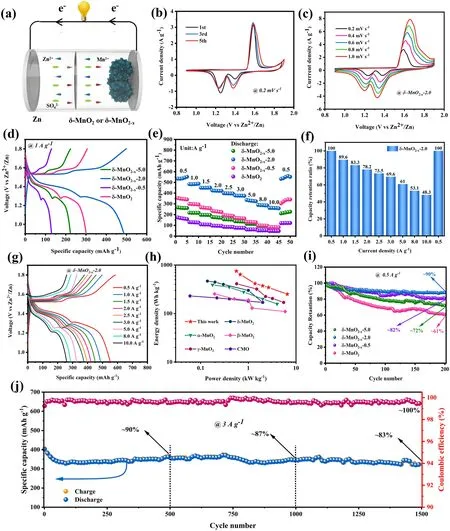
Fig.3 a Electrochemical performances of the δ-MnO2, δ-MnO2-x-0.5, δ-MnO2-x-2.0 and δ-MnO2-x-5.0 electrodes in ZIBs.Configuration of the aqueous ZIB with Zn foil as anode and the as-prepared δ-MnO2 or δ-MnO2-x as cathode.b CV curves of δ-MnO2-x-2.0 at 0.2 mV s-1 for the initial five cycles.c CV curves of δ-MnO2-x-2.0 at 0.2 ~ 1.0 mV s-1.d Galvanostatic charge/discharge (GCD) plots of these obtained cathodes at 1.0 A g-1.e Rate performance.f Capacity retention rate of δ-MnO2-x-2.0.g GCD curves of δ-MnO2-x-2.0 at different current densities.h Ragone plots of δ-MnO2-x-2.0-based aqueous ZIBs with other types of cathode materials.i, j The cycling stability and coulombic efficiency at various current densities
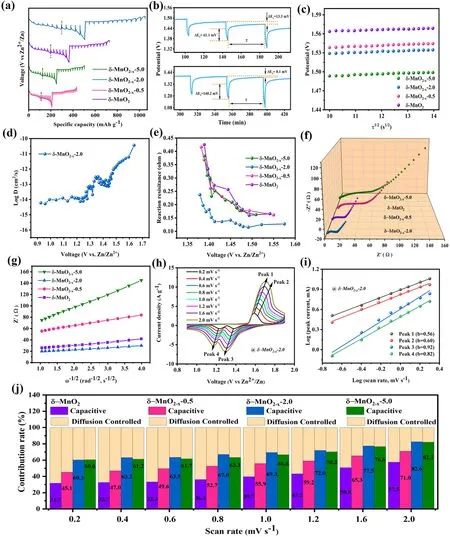
Fig.4 Kinetic analysis of the obtained δ-MnO2, δ-MnO2-x-0.5, δ-MnO2-x-2.0 and δ-MnO2-x-5.0 cathodes.a GITT profiles.b Titration plots with a schematic illustration of different parameters.c Variation of the potential against τ1/2.d In situ zinc-ion diffusion coefficient of δ-MnO2-x-2.0.e Reaction resistances of the δ-MnO2, δ-MnO2-x-0.5, δ-MnO2-x-2.0 and δ-MnO2-x-5.0, respectively.f EIS spectra and g the corresponding relationship between Zreal and ω-1/2 of the δ-MnO2, δ-MnO2-x-0.5, δ-MnO2-x-2.0 and δ-MnO2-x-5.0.h CV curves at different scan rates and i log i versus log v plots at four peaks of the δ-MnO2-x-2.0 cathode.j Contribution ratios of capacitive-like and diffusion-controlled capacities at different scan rates for the δ-MnO2, δ-MnO2-x-0.5, δ-MnO2-x-2.0 and δ-MnO2-x-5.0 cathodes
To compare the electrochemical performances ofδ-MnO2,δ-MnO2-x-0.5,δ-MnO2-x-2.0 andδ-MnO2-x-5.0 electrodes, the coin-type ZIBs were fabricated via employing Zn foil as anode,δ-MnO2orδ-MnO2-xas cathode and 2.0 M ZnSO4/0.1 M MnSO4mixed solution as electrolyte, as shown in Fig.3a.Based on the previous reports [59], the dissolution of Mn2+can be effectively hindered by adding sufficient Mn2+into the electrolyte during the charging process since it contributes to the formation of MnO2, significantly improving the effectiveness of the Zn plating and stripping.Thus, the electrolyte configuration plays a crucial role in promoting the electrochemical properties of the energy storage system [60].Electrochemical properties of these obtained cathodes were achieved by CV tests in the voltage range of 0.9-1.9 V (vs.Zn2+/Zn) as shown in Figs.3b-d and S2.Figure 3b presents the CV curves ofδ-MnO2-x-2.0 from the first to the third cycles taken at 0.6 mV s-1.The two pairs of redox peaks suggest that the ZIB has experienced a two-step electrochemical reaction that refers to the insertion/extraction of H+and Zn2+ions.The CV curve area is continuously enlarged as the cycle continues for the initial five cycles, revealing the gradual activation process of the electrode materials [61].Then, the excellent coincidence of the CV profile shapes in subsequent cycles illustrates that the redox reaction holds prominent reversibility and stability.Meanwhile, the CV measurements of theδ-MnO2-x-2.0 at various scan rates of 0.2-1.0 mV s-1(Fig.3c) were also conducted, which presents that all curves have a similar shape with two major pairs of redox peaks, and there is no distinct peak shift even at the high scan rate, indicating the favorable electronic/ionic conductivity.Moreover, galvanostatic charge/discharge (GCD) curves ofδ-MnO2andδ-MnO2-xat the same current density of 1 A g-1are compared in Fig.3d,which clearly display that there are two discharge plateaus in the GCD curves located at ~ 1.59 and 1.29 V, respectively.According to the previous literature of MnO2-based aqueous ZIBs [62], the initial discharge platform corresponds to H+insertion, while the later one is ascribed to Zn2+insertion,which is almost in agreement with the oxidation and reduction peaks in CV plots.Among these obtained cathodes, theδ-MnO2-x-2.0 can deliver superior electrochemical activity and larger reversible capacity of 551.8 mAh g-1than those of the other cathodes (173.5, 348.5 and 266.8 mAh g-1).Rate capability as an essential indicator for the realistic application ofδ-MnO2andδ-MnO2-xin aqueous ZIBs is assessed at 0.5 ~ 10.0 A g-1(Figs.3e-g and S3).From Figs.3e, f and S4, when the current density is 0.5, 1.0, 1.5, 2.0, 2.5, 3.0 and 5.0 A g-1, respectively, the specific capacities of 551.8,487.1, 451.0, 420.7, 396.3, 375.4 and 328.6 mAh g-1are achieved forδ-MnO2-x-2.0 cathode.As the current density increases to 10.0 A g-1, it can still hold a reversible capacity of 262.2 mAh g-1with 48% capacity retention, substantiating the outstanding rate performance ofδ-MnO2-x-2.0 cathode.In contrast, the pristineδ-MnO2,δ-MnO2-0.5 andδ-MnO2-5.0 cathodes only present a lower capacity retention rate of 23.9%, 28.2% and 31.1% at 10.0 A g-1, respectively.Also, the corresponding GCD curves of these cathodes at various current densities further verify the best electrochemical performances ofδ-MnO2-x-2.0 among the as-prepared cathodes (Figs.3g and S4).The performance comparison of theδ-MnO2-x-2.0 with different reported transition metal compound cathodes in aqueous ZIBs is shown in Table S1.Obviously, theδ-MnO2-x-2.0 presents larger capacity and higher rate capability than those of the other products, which may be benefited from the enhanced electronic conductivity and ion chemisorption-desorption equilibrium, as well as the sufficient electroactive sites owing to the effective modulation of the oxygen vacancies in theδ-MnO2.The Ragone plots in Fig.3g clearly suggest that the energy density ofδ-MnO2-x-2.0 is 747.5 Wh kg-1at a power density of 561.6 W kg-1, and its energy density can still maintain 373.5 Wh kg-1when the power density is increased to 2000 W kg-1, which outperforms other ZIB cathodes such asδ-MnO2[63],α-MnO2[59],β-MnO2[64],γ-MnO2[65] and CMO [66].In addition, the obtainedδ-MnO2-x-2.0 cathode can display excellent cycling stability as shown in Fig.3i and j.Specifically, the capacity retention ofδ-MnO2-x-2.0 is ~ 90% after 200 continuous charge/discharge cycles at 0.5 A g-1, which is superior than those of other prepared cathodes (~ 82%, ~ 61% and ~ 72% forδ-MnO2,δ-MnO2-x-0.5 andδ-MnO2-x-5.0, respectively).More significantly, theδ-MnO2-x-2.0 can still preserve ~ 83% capacity retention and ~ 100% coulombic efficiency after 1500 cycles even at a high current density of 3.0 A g-1, demonstrating the remarkable long-term cycling lifespan.Thus, theδ-MnO2-x-2.0 electrode possesses an excellent cycling stability, which is also clearly more favorable than those of the other batterytype electrodes in prior reports displayed in Table S2.
GITT and electrochemical impedance spectroscopy(EIS) and CV measurements were employed to probe the energy storage mechanism and kinetic behaviors, as displayed in Fig.4.As for theδ-MnO2-x-2.0 cathode, the GITT profile the amplified titration curves with a schematic illustration ofΔEs,ΔEτ and τ (in whichΔEs is the voltage change between steps,ΔEτ and τ are the voltage change and the constant current pulse, respectively) show that the total overvoltage (13.3 mV) of theδ-MnO2-x-2.0 cathode in region II is about 1.64 times that of the value(8.1 mV) in region I, which is induced by a large voltage jump and sluggish ion diffusion in region II (Fig.4a and b).According to the previous study [62], it is found that the first discharge platform corresponds to the intercalation of H+, while the second discharge platform is mainly assigned to the intercalation of Zn2+.The other obtained cathodes can also present similar phenomenon (Fig.4a).Then, combined with the linear variation of the potential against τ1/2(Fig.4c) and Fick’s second law, the corresponding diffusion coefficients of the as-fabricatedδ-MnO2,δ-MnO2-x-0.5,δ-MnO2-x-2.0 andδ-MnO2-x-5.0 cathodes can be ascertained.As can be seen from the calculated results (Fig.4d),the diffusion coefficient of theδ-MnO2-x-2.0 in the first stage (10-11-10-14cm2s-1) is greatly larger than that of the second one (10-14-10-15cm2s-1).The apparently decreased diffusion coefficient of the second stage illustrates that the intercalated cation species are different.Given the difference in ionic radius size of H+and Zn2+, the H+intercalation with smaller radius size may refer to the first discharge plateaus, and the second platform should conduct Zn2+insertion, further certifying the H+and Zn2+co-insertion in theδ-MnO2-x-2.0 cathode.Notably, the diffusion coefficient of theδ-MnO2-x-2.0 is significantly higher than those of the other obtained cathodes (Figs.4d and S5),suggesting its more excellent kinetic behaviors, which is largely attributed to the vital role of the introduced moderate vacancies in facilitating ion diffusion.Moreover, during the electrochemical reaction, the in situ reaction resistance at various Zn2+insertion/extraction stages can be calculated on the basis of the closed-circuit voltage (CCV) and quasi-open-circuit voltage (QOCV) of the GITT profiles[67].As depicted in Fig.4e, the reaction resistance of theδ-MnO2-x-2.0 is lowest among these cathodes, which effectively accelerates the charge transmission kinetics for efficient Zn2+storage.Furthermore, the EIS spectra and the corresponding relationship between Zrealand ω-1/2, as well as the capacitive/diffusion-controlled contribution,are tested to achieve a deep understanding of the kinetic behaviors ofδ-MnO2,δ-MnO2-x-0.5,δ-MnO2-x-2.0 andδ-MnO2-x-5.0 cathodes, as displayed in Fig.4f-j.It can obviously find that theδ-MnO2-x-2.0 not only delivers the lower intrinsic resistance (Rs) than those of the counterpart samples, but also presents a more satisfied straight line along the imaginary axis, illuminating a smaller diffusion resistance (Rw) for effective ion transport (Fig.4f).Besides, the relationship between Zrealand ω-1/2ofδ-MnO2,δ-MnO2-x-0.5,δ-MnO2-x-2.0 andδ-MnO2-x-5.0 is also determined in Fig.4g based on Eq.(3) [68]:
Theoretically, the smaller Warburg factor (σ) of the cathode,the rapider the ion diffusion rate.The σ of theδ-MnO2-x-2.0 is 3.3, which is much lower than those ofδ-MnO2(5.3),δ-MnO2-x-0.5 (9.5) andδ-MnO2-x-5.0 (23.2), effectively verifying that theδ-MnO2-x-2.0 possesses the faster ion diffusion rate.In addition, in light of the CV curves at different scan rates (Fig.4h), the electrochemical kinetics source can be defined via Eq.(4) [69]:
in whichi(A) is the peak current, a and b are adjustable parameters andv(mV s-1) is the scan rate [70].Based on the linear relation, the b values of the four peak currents for theδ-MnO2-x-2.0 can be calculated to be 0.61 (peak 1),0.62 (peak 2), 0.82 (peak 3) and 0.65 (peak 4), respectively(Fig.4i), indicating that the capacitive-controlled behavior and diffusion-limited contribution synergistically dominate the charge storage process [71, 72].The obtained b values of theδ-MnO2-x-2.0 are larger than those of theδ-MnO2,δ-MnO2-x-0.5 andδ-MnO2-x-5.0 (Fig.S6), which reveals that the electrochemical reaction of theδ-MnO2-x-2.0 preserves more capacitive behavior compared with the other cathodes.The contributions of capacitance (k1v) and diffusion (k2v1/2) components are further quantified according to Eq.(5) [73]:
whereiis the current at a fixed potential.The capacitive contribution ratios at various scan rates are achieved as displayed in Fig.4j.Obviously, the capacitive contribution of theδ-MnO2-x-2.0 accounts for 60.3% of the total capacity at 0.2 mV s-1, and it gradually increases to 82.6% when the scan rate reaches 2.0 mV s-1, which is larger compared to the other cathodes, substantiating the faster electrochemical kinetics.The favorable capacitive behavior together with the rapid Zn2+diffusivity is responsible for the satisfactory rate capability of theδ-MnO2-x-2.0 cathode.
3.3 Theoretical Insight into the Optimum Performances
To further deeply understand the positive effects of vacancy modulation on improving the electrochemical performances,density functional theory (DFT) calculations were performed, and the corresponding analysis results are shown in Fig.5.The geometry configurations of theδ-MnO2,δ-MnO2-x-0.5,δ-MnO2-x-2.0 andδ-MnO2-x-5.0, as well as the adsorbed H+/Zn2+at the above models, were optimized (Figs.S7-S8).The charge storage mechanism for the cathode materials can be unveiled through Eqs.(6-9) [74],which is also analyzed detailly in the following discussion(Fig.6):
where H+/Zn2+ions all involve the charge/discharge process.To illustrate the redox activity and charge storage reversibility, the adsorption energy of H+/Zn2+(ΔEH+/ΔEZn2+).
on the above cathodes and the Gibbs free energy (ΔGH+/ΔGZn2+) of the redox reactionswere estimated, as shown in Fig.5a-d.Specifically, ΔEH+ofδ-MnO2,δ-MnO2-x-0.5,δ-MnO2-x-2.0 andδ-MnO2-x-5.0 is -0.757, -0.989, -1.15 and -1.35 eV, respectively (Fig.5a), and their ΔEZn2+is-0.58, -0.734, -0.807 and 1.39 eV (Fig.5b).These data indicate that the H+/Zn2+adsorption strength ofδ-MnO2with oxygen vacancies is significantly higher than that of bareδ-MnO2.With the increases in the oxygen vacancies created inδ-MnO2, the H+/Zn2+adsorption strength is further enhanced.Thus, the H+/Zn2+value ofδ-MnO2-x-5.0 is the largest among these samples.A similar trend is observed for the Gibbs free energies of the Zn4SO4(OH)6.4H2O and ZnMn2O4formation reaction, as displayed in Fig.5c and d.Thus, for the discharging process (right arrows) expressed using formula 7, the vacancy engineering can elevate the reaction rate and specific capacity.Theoretically, theδ-MnO2-x-5.0 cathode possesses prominent electrochemical performances, whereas theδ-MnO2-x-2.0 cathode(corresponding ΔGH+= -1.12 eV, ΔGZn2+= -1.24 eV)verifies the highest specific capacity and rate capability in practice.It is because extremely robust H+/Zn2+binding strength referring toδ-MnO2-x-5.0 (ΔGH+= -1.35 eV,ΔGZn2+= -1.40 eV) may give rise to more difficulties in completing the charge reaction (left arrows) than that of theδ-MnO2-x-2.0, bringing about immensely inferior reversibility inδ-MnO2-x-5.0.Accordingly,δ-MnO2-x-2.0 provides relatively strong and moderate H+/Zn2+absorption capability compared to the other obtained cathode materials.Therefore, theδ-MnO2-x-2.0 displays optimal H+/Zn2+chemisorption-desorption equilibrium, which makes the reversible reactions easier to proceed, effectively accelerating the charge transfer rate during the redox reaction process and further demonstrating outstanding rate capability.Meanwhile, it greatly enhances the reaction activities,substantially guaranteeing the high capacity.Based on the above results, the introduced oxygen vacancies in the cathode materials own an optimal level rather than an infinitely improving vacancy concentration.Thus, our study offers a unique path for determining the optimal vacancy concentration, which is of extreme significance for constructing high-performance ZIBs cathode materials.In order to explore the bonding properties of the adsorbed H+/Zn2+in the optimalδ-MnO2-x-2.0 andδ-MnO2, the corresponding electron density difference was calculated presented in Figs.5e, f and S8, respectively.Evidently, the charge difference maps of the adsorbed H+/Zn2+at theδ-MnO2-x-2.0 in Fig.5e and f present noticeable migration of valence electrons, wherein it holds larger accumulation/depletion area than that of the pristineδ-MnO2(Fig.S8), which is quantitatively testified using the Bader charge analysis (the specific charge transfer level is 0.65/0.15 e and 0.52/0.39 e forδ-MnO2-x-2.0 andδ-MnO2, respectively, Fig.5g).The above analysis indicates that more redox reactions betweenδ-MnO2-x-2.0 and H+/Zn2+can occur owing to the moderate oxygen vacancy states, thereby rendering higher charge storage capacity.In addition, the density of states(DOS) of theδ-MnO2-x-2.0 andδ-MnO2(Fig.5h and i)obviously display a higher intensity near the Fermi level inδ-MnO2-x-2.0 compared with theδ-MnO2, which reveals that theδ-MnO2-x-2.0 can deliver more excellent electronic conductivity than that of the preparedδ-MnO2cathode.The theoretical calculation is consistent with our experimental results, which fundamentally uncovers the reasons why theδ-MnO2cathode with moderate oxygen vacancies can manifest high-rate property and large capacity.
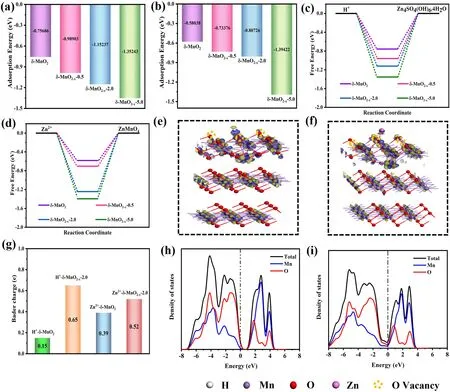
Fig.5 DFT calculations of the prepared cathode materials.The adsorption energies of a H+ and b Zn2+ on δ-MnO2, δ-MnO2-x-0.5,δ-MnO2-x-2.0 and δ-MnO2-x-5.0, respectively.c, d Gibbs free energy diagram of charging storage on these samples.The differential charge density maps of δ-MnO2-x-2.0 with e H+ and f Zn2+ adsorption and g the corresponding Bader charges, in which yellow and blue areas stand for the electron accumulation and depletion, respectively.The density of states (DOS) of the h δ-MnO2 and i δ-MnO2-x-2.0
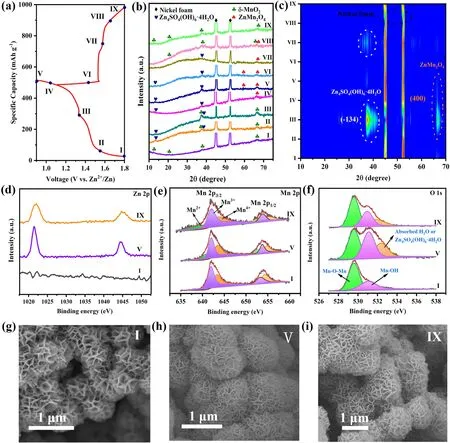
Fig.6 a Charge storage mechanism of δ-MnO2-x-2.0 cathode based on the ex situ characterization technique.GCD plots of the δ-MnO2-x-2.0 at different charge/discharge steps.b, c Ex situ XRD patterns of the δ-MnO2-x-2.0 at different charge/discharge states.Ex situ XPS high-resolution spectra of d Zn 2p, e Mn 2p and f O 1s of the δ-MnO2-x-2.0 at different charge/discharge stages.g-i Ex situ SEM images of the the δ-MnO2-x-2.0 during various electrochemical steps
3.4 Charge Storage Mechanism of the δ-MnO2-x-2.0
To further explore the energy storage mechanism of theδ-MnO2-x-2.0 cathode, a series of ex situ XRD, XPS and SEM measurements were carried out at the specific charged and discharged states based on the first GCD profiles presented in Fig.6a.Figure 6b and c illustrates its ex situ XRD patterns at various states in the discharge/charge process, which clearly manifests that during the first discharge platform (point I), there are four major diffraction peaks of theδ-MnO2located at 12.2°, 24.7°,36.8° and 66.2° can be clearly observed, and the other two strong diffraction peaks centered at 45.4° and 52.6°are assigned to nickel foam substrate.Subsequently, some new peaks at 13.5° and 37.6° marked by the blue symbol resulted from the points II and III can match well with the zinc sulfate hydroxide hydrate (ZSH, Zn4SO4(OH)6.4H2O,JCPDS No.44-0673) [75, 76].The generation of ZSH is attributed to the enhanced amount of OH-along with theconsumption of H+, which is consistent well with the previous studies [77, 78].Noted that no apparent peak of MnOOH is probed in theexsitu XRD patterns, presumably due to the H+inserting into the interlayer ofδ-MnO2[79].Except for the peaks of ZSH, the typical peaks of the ZnMn2O4(ZMO, JCPDS No.77-0470) phase labeled by red symbol at 59.1° and 66.3° can be detected during the discharge process (points IV and V) because of the Zn2+intercalation.In the following charging process (points VI-IX), these new emerged diffraction peaks of the above produced ZSH and ZMO gradually vanish, and then, the intrinsic peaks of theδ-MnO2can also recover well, indicating the superior reversibility of theδ-MnO2-x-2.0 cathode.Furthermore, the ex situ XPS tests were utilized to further demonstrate the phase transition mechanism during the discharge/charge process.In terms of the highresolution Zn 2pspectra (Fig.6d), no peaks are found in the initial state (I state), which suggests that the Zn element does not exist in theδ-MnO2-x-2.0.After discharging to V state, a pair of evident characteristic peak signals located at 1022.2 and 1044.8 eV are detected resulted from the insertion of Zn2+into theδ-MnO2-x-2.0 or the generation of the ZSH products, but the peaks intensities are greatly decreased induced by most of the Zn2+extraction from the cathode or the decomposition of ZSH after recharging to IX state.Figure 6e shows the high-resolution Mn 2pspectra at different stages.Compared with the pristine I state, a new peak discovered at 641.6 eV is ascribed to Mn2+, and the peaks intensities of Mn3+and Mn4+obviously diminish at fully discharged V state,which further substantiates the reduction of Mn3+and Mn4+caused by the Zn2+insertion according to Eq.(10).When the cathode was charged to IX state again, the peak integral area of Mn3+and Mn4+can be also significantly augmented owing to the extraction of Zn2+from the cathode.Notably, the Mn2+peak signal does not completely disappear, which can be mainly attributed to the captured Zn2+in the cathode.Moreover, the O 2pspectra (Fig.6f)show that an apparent peak located at 532.8 eV can be observed, which can correspond to the formed ZSH or absorbed H2O after discharging to V state, and the peak intensity enormously reduces at fully charged IX state because of the decomposition of ZSH and the extraction of H2O.In addition, the micro-morphology evolution of theδ-MnO2-x-2.0 cathode materials was further investigated usingex situSEM characterization (Figs.6g-i and S9).As for the initial state (I state), there is no obvious change of the flower-like morphology on the cathode materials surface.However, when it was discharged to V state, these nanosheets become thicker and rougher caused by the initially generated ZSH and ZMO products on their surface, and then almost completely disappeared at IX state.The highly reversible behaviors during the discharge/charge process accord well with the aforementioned ex situ XRD and XPS analysis results and the previously reportedex situcharacterizations [80].
4 Conclusions
In summary, oxygen vacancies modulation strategies have been successfully employed to construct the unique flowerlikeδ-MnO2nanostructures with moderate oxygen vacancies as the advanced ZIB cathodes.The created moderate oxygen vacancies inδ-MnO2(δ-MnO2-x-2.0) not only effectively ensures H+/Zn2+chemisorption-desorption equilibrium,making the redox reactions easier to proceed and further accelerating the electron transfer rate during the reactions,but also intrinsically enhances electrochemical activity and electrical conductivity, leading to faster reaction kinetics and more reversible redox reactions, as demonstrated by the series of the test techniques and the corresponding DFT calculations.Benefiting from the above advantages, the preparedδ-MnO2-x-2.0//Zn ZIBs can deliver a maximum specific capacity of 551.8 mAh g-1at 0.5 A g-1, ultrahigh rate capability (262.2 mAh g-1even at 10 A g-1) and a long-term cycle lifespan with a capacity retention ~ 90% after 1500 cycles.Meanwhile, the assembled ZIBs can also present a large energy density of 373.5 Wh kg-1at 2.0 kW kg-1,and when the power density is increased to 747.5 kW kg-1,it still possesses the favorable energy density of 561.6 Wh kg-1.This work both provides a potential cathode candidate for next-generation aqueous ZIBs and unfolds an effective vacancy modulation strategy for constructing the other highperformance battery electrode materials.
AcknowledgementsThis study was supported by the National Natural Science Foundation of China under Grant Nos.52072196,52002200, 52102106 and 52002199, Major Basic Research Program of the Natural Science Foundation of Shandong Province under Grant No.ZR2020ZD09, the Natural Science Foundation of Shandong Province under Grant No.ZR2020QE063, the Innovation and Technology Program of Shandong Province under Grant No.2020KJA004 and the Taishan Scholars Program of Shandong Province under Grant No.ts201511034.We are grateful to them for their financial support.
FundingOpen access funding provided by Shanghai Jiao Tong University.
Declarations
Conflict of InterestThe authors declare no interest conflict.They have no known competing financial interests or personal relationships that could have appeared to influence the work reported in this paper.
Open AccessThis article is licenced under a Creative Commons Attribution 4.0 International License, which permits use, sharing,adaptation, distribution and reproduction in any medium or format,as long as you give appropriate credit to the original author(s) and the source, provide a link to the Creative Commons licence and indicate if changes were made.The images or other third-party material in this article are included in the article’s Creative Commons licence, unless indicated otherwise in a credit line to the material.If material is not included in the article’s Creative Commons licence and your intended use is not permitted by statutory regulation or exceeds the permitted use, you will need to obtain permission directly from the copyright holder.To view a copy of this licence, visit http:// creat iveco mmons.org/ licen ses/ by/4.0/.
Supplementary InformationThe online version contains supplementary material available at https:// doi.org/ 10.1007/s40820- 023- 01194-3.
- Nano-Micro Letters的其它文章
- Intelligent Vascularized 3D/4D/5D/6D-Printed Tissue Scaffolds
- Humanoid Intelligent Display Platform for Audiovisual Interaction and Sound Identification
- Initiating Binary Metal Oxides Microcubes Electromagnetic Wave Absorber Toward Ultrabroad Absorption Bandwidth Through Interfacial and Defects Modulation
- Diverse Structural Design Strategies of MXene-Based Macrostructure for High-Performance Electromagnetic Interference Shielding
- Atomic Cu Sites Engineering Enables Efficient CO2 Electroreduction to Methane with High CH4/C2H4 Ratio
- Hetero Nucleus Growth Stabilizing Zinc Anode for High-Biosecurity Zinc-Ion Batteries

